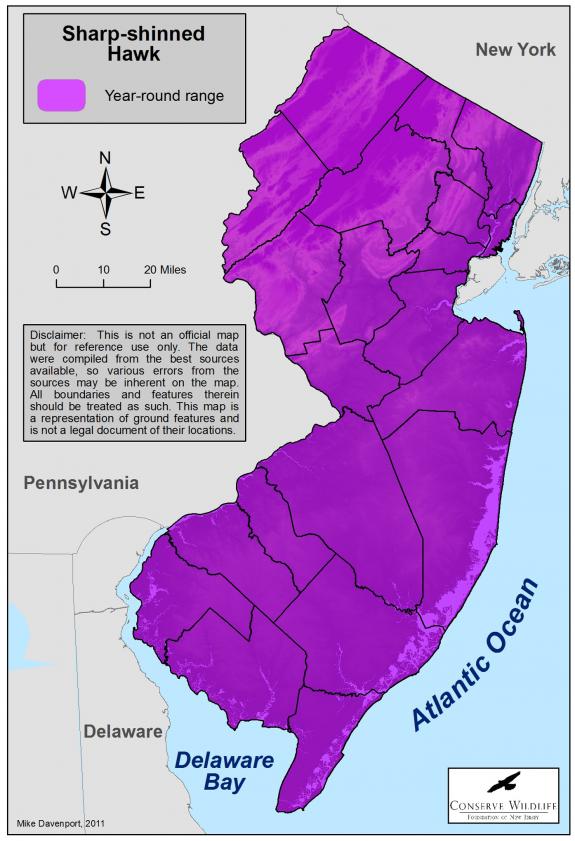Accipiter striatus
Type: bird
Status: special concern
Species Guide
Sharp-shinned hawk
Accipiter striatus
Species Type: bird
Conservation Status: special concern
IDENTIFICATION
The sharp-shinned hawk is a small, slim hawk with short, rounded wings. The square tip of the long, barred tail is a key in determining it from its very similar cousin, the cooper’s hawk. The sharp-shinned hawk has a slate (blue/gray) colored back with reddish barring underneath. Females are very similar in coloration to males; however females are almost double the size of males.
Juvenile sharp-shinned hawks are typically brown on the back and wings. Their underwings and chest are white with dark brown barring. The juveniles have yellow eyes while the adults have red eyes.
As mentioned above, the sharp-shinned is easily confused with the cooper’s hawk. The cooper’s is overall, much larger in size and has a longer, rounded tail. The sharp-shinned also lacks the prominent dark head cap that the cooper’s has.

Distribution & Habitat
Most of the breeding population of sharp-shinned hawks in New Jersey is located in the northwest portion of the state. There are some pairs located in southern New Jersey. Our breeding population is mainly residential. However, some do migrate for the winter.
Migrant sharp-shinned hawks breed in Canada, Alaska, and the northern United States. The eastern and western United States’ populations are typically residential, meaning they do not leave their breeding grounds in the winter. They are rarely seen during the breeding season making them difficult to census. During fall migration, Cape May, NJ is one of the most popular places to see Sharp-shinned hawks. On one day in 1977, over 11,000 migrant sharp-shinned hawks were recorded at Cape May Point. The migrating population winters in the southern United States, Mexico, and Central America.
Breeding sharp-shinned hawks prefer boreal coniferous forests close to open areas and deciduous woodlands. They avoid open, deciduous forests. In the winter, they are often found in a wider variety of habitat including urban and suburban areas.
Diet
The sharp-shinned hawk is described as a secretive, opportunistic hunter. Their favorite prey is small to medium-sized birds. Sharp-shinned hawks have a long history of using areas around homes to prey on small birds at bird feeders. It has been noted that perhaps fewer hawks are migrating south as they already have a dependable food source at bird feeders. They will also feed on small mammals and occasionally on large insects.
Sharp-shinned hawks hunt from inconspicuous perches or by stealthy flights. They rely on the element of surprise, attacking from a perch or from flight. They will also forage in the forest and along fields and shorelines.
Sharp-shinned hawks have an unusual fledging feeding behavior. As the chicks leave the nest, the adults bring food and pass it in mid-air to the new fledglings. Passing it to them, they hover briefly and kick the prey outward just as the young arrive to take it from them.
Life Cycle
From April into early May, sharp-shinned hawks arrive on their breeding grounds and begin forming pair bonds. Pairs are presumably monogamous. Males have high territory fidelity. However, pairs do not use the same nest year to year. Females build nests from freshly broken twigs and line it with bark. They often place the nest against the trunk of a mature tree. A 4-5 egg clutch is laid in mid-May. The eggs are white to bluish white with some splotches of brown. The female primarily incubates the nest for 30-32 days while the male brings her food.
When the young hatch, they are covered with down and their eyes are open. Brooded by the female for 16-23 days, the male takes on the responsibility of feeding both the female and the chicks. After 3-4 weeks, the chicks leave the nest. The young are dependent on the adults for food for 3 weeks after fledging. Sharp-shinned hawks typically return to breed at 2 years of age. Occasionally they return as yearlings to breed.
Current Threats, Status, and Conservation
In New Jersey, the sharp-shinned hawk is listed as a species of Special Concern. They are listed federally as partial status under the Endangered Species Act. This partial status indicates that the status applies only to a portion of the species’ range.
It is widely known that pesticides greatly impact the sharp-shinned hawk’s ability to breed successfully. Damaging pesticides in the United States have been outlawed for years, but they are still widely used in Latin America where sharp-shinned hawks winter. It is also presumed that the illegal hunting of these birds still takes place in the United States and Canada. Seen as a pest species at bird feeders, these raptors are often targeted during migration. They are also frequently hit by cars and fly into windows.
Migration counts performed every year in Cape May, NJ have shown a decline in sharp-shinned hawks. However, breeding surveys have indicated the population is increasing. Sharp-shinned hawks are not often monitored due to their secretive nature during the breeding and wintering seasons. Their habitat requirements are not well known, currently leaving researchers with assumptions. A further understanding of their sensitivity to forest fragmentation and their habitat preference in general will greatly benefit a healthy population.
References
Text written by Emily Heiser in 2011.
Scientific Classification
- Kingdom: Animalia
- Phylum: Chordata
- Class: Aves
- Order: Falconiformes
- Family: Accipitridae
- Genus: Accipiter
- Species: A. striatus